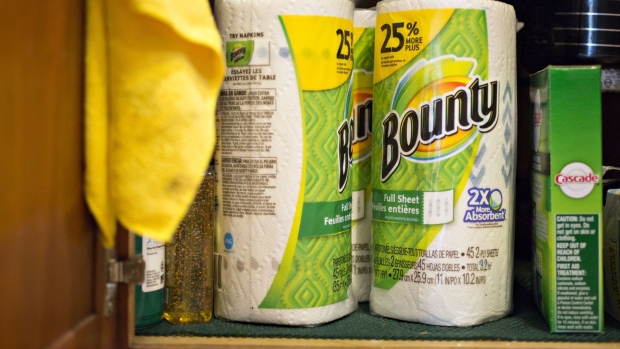Jan 19, 2023
P&G Relies on Price Hikes to Prop Up Sales as Volumes Shrink
, Bloomberg News

(Bloomberg) -- Procter & Gamble Co. sold fewer household staples than expected last quarter as consumers grew more cautious about higher prices.
The total volume of goods sold fell 6% in the three months ended in December, worse than the 2.6% decline that analysts had estimated. Chief Financial Officer Andre Schulten said in an interview that shoppers are finishing off the products in their pantries before restocking, and they’re being more measured in their use of items such as paper towels.
Inflation has curtailed consumer spending, putting an end to the pandemic boom that the maker of Tide detergent and Pampers diapers had experienced. Volume fell in all categories, P&G said Thursday, citing a “market contraction” for most, according to a statement Thursday. Even so, shoppers’ reaction to price hikes is “much more benign than we would’ve expected,” Schulten said.
P&G is one of many companies that have passed on higher costs to consumers, with prices rising about 10% last quarter alone. That propelled organic sales up 5% even as the company sold fewer items. The metric, which excludes factors such as currency fluctuations, surpassed analysts’ expectations but was still the slowest expansion rate in more than a year.
Shares of P&G slipped 1.7% in New York trading at 9:36 a.m. The stock had been on a recent ascent, climbing about 18% from its October lows through Wednesday’s close.
Investors are closely watching consumer spending amid signs of a global economic pullback. US retail sales fell in December by the most in a year, adding to a drop the prior month, according to Commerce Department data released Wednesday. Factory output also slumped, exacerbating concerns that a recession is looming.
In a statement announcing the results, Chief Executive Officer Jon Moeller acknowledged the “very difficult cost and operating environment,” while adding that P&G’s actions have helped it to maintain growth despite the challenges.
The company is taking a different approach than it did during the 2008 recession. It now offers a broader range of price points for its products, allowing it to retain consumers even if they need to downgrade from higher-end laundry detergent or shampoo to a cheaper product. P&G frequently says that the efficacy of its products will keep shoppers buying even in an economic downturn.
Global Slowdown
The Cincinnati-based company is “encouraged” by the quarterly results in part because its biggest market, the US, continues to be resilient, Schulten said on a call with reporters. The consumer-goods giant now sees organic sales growth between 4% and 5% in the fiscal year ending in June. That narrows the projection to the more optimistic half of its previous forecast, issued in October.
In addition, the company trimmed the anticipated impact of currency fluctuations as well as higher commodity and freight costs for the full year. It now foresees a $3.7 billion hit, down from $3.9 billion, thanks in part to a weaker dollar. Still, P&G maintained its earnings per share outlook in a range of $5.81 to $6.04 for the current fiscal year.
The dollar has tumbled in recent weeks from peak levels, offering some relief for US companies that operate overseas.
“While improving slightly, it appears cost and FX headwinds continue to negatively impact the bottom line,” said Bill Chappell, an analyst at Truist Securities, in a note to clients. “In the near-term, we believe leaving the bottom-line guide unchanged is prudent given the dynamic environment, especially internationally (Europe and China), but we sense a bit of conservatism” for the second half of the fiscal year.
P&G’s business in China — the firm’s second-largest market — slumped 7% last quarter as cash-strapped retailers reduced their inventories amid Covid-19 restrictions, Schulten said. Meanwhile, Europe has shown a “higher and more pronounced reaction” to elevated prices than the US, Schulten said.
--With assistance from Chester Dawson and Karen Lin.
(Updates with analyst comment in 12th paragraph.)
©2023 Bloomberg L.P.






